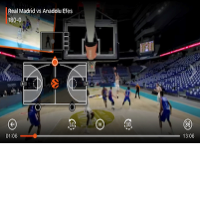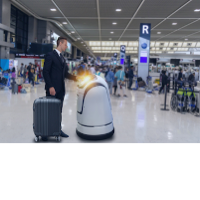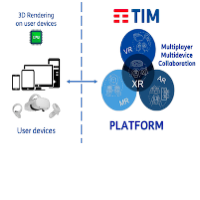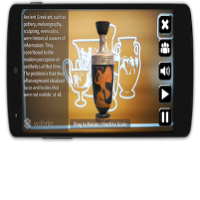Culture, Tourism & Entertainment domain
The CTE domain offers the possibility to stretch the network performance requirements because it needs in all the scenarios low latency, high bandwidth availability and reliable performance for all the users involved. For example, VR and AR can be used to enhance the visitor experience at cultural heritage sites and museums, providing interactive and immersive experiences and educational opportunities. In the entertainment industry, B5G technologies can enhance the quality and reliability of streaming services, allowing for a more seamless and enjoyable experience for consumers. Therefore, the CTE domain can greatly benefit from B5G technologies. From a societal perspective, culture, tourism, and entertainment are significant drivers of economic growth, job creation, and social development. The integration of SNS and B5G technologies can help to further stimulate these industries by creating new business opportunities and improving the delivery of cultural and entertainment services. Additionally, it can also help to promote cultural exchange and understanding, fostering a more diverse and inclusive society. It is also important for stakeholders to consider the opportunities and challenges posed by these technologies and work together to ensure that they are used in ways that are beneficial for society. Some examples in which SNS and B5G technologies can impact the CTE domain are provided below.
Culture
Virtual and Augmented Reality: SNS and B5G systems can provide new opportunities for people to access and experience cultural events and heritage sites. For example, VR and AR can be used to create virtual tours of museums, historical sites, and cultural landmarks, allowing visitors to experience them as if they were there. This can help to promote cultural education and appreciation, as well as provide new opportunities for cultural organizations to reach a wider audience. It can also help to enrich the experiences onsite with more engaging experiences for different targets or to link different audiences on site and online, with multiple possibilities to promote unexpected interactions.
Online Collections and Exhibitions: Advanced network technologies can be used to digitize and preserve cultural heritage in many ways, making it more accessible and widely available to people around the world. Firstly, online collections and exhibitions can provide access to a wide range of cultural artifacts, artworks, and other historical items from anywhere in the world. People can learn about different cultures and civilizations, no matter where they are located. This type of digital access can be particularly valuable for those who cannot physically visit museums or cultural sites due to geographic or financial limitations. In addition, SNS and B5G systems can facilitate the creation of more immersive and interactive experiences for visitors, whether onsite or online. For example, visitors to a museum could use AR and/or VR to gain a deeper understanding of the collections or historical context of an exhibit. They could also access additional information, such as videos, audio recordings, or expert commentary, through their mobile devices or other digital platforms. Moreover, these technologies can also help to preserve cultural heritage for future generations. By creating high-resolution images, 3D models, and other digital records of artifacts, museums, and cultural institutions can protect these valuable items from physical damage or loss.
Interactive Storytelling: Interactive installations and exhibits that use mobile network technology such as VR and AR can create immersive experiences that allow visitors to engage with cultural heritage in exciting and novel ways. For example, VR can transport visitors to different historical periods, allowing them to experience what life was like in ancient civilizations, or what it was like to live during pivotal moments in history. Similarly, AR can bring exhibits to life, overlaying additional information, animations, and interactive elements onto physical displays to enhance visitors’ understanding and engagement. Beyond just exhibitions, SNS and B5G systems can also be used to foster a sense of community around cultural heritage which can be termed as “social metaverse”. For example, social media platforms can be used to share stories and anecdotes from different cultures, creating a space for people to connect and learn from each other. This can help to promote cross-cultural understanding and appreciation, which is particularly important in our increasingly globalized world.
Tourism
Virtual Tourist/Traveller Experiences: SNS and B5G systems can provide new and innovative ways for people to experience and explore tourist destinations, as well as to assist them with personalized services to organize their transportation needs. For example, VR can be used to create virtual tours of tourist/traveller attractions, allowing people to experience them as if they were actually there. This can help to promote accessibility to tourist locations (even the hardest ones to reach) for all and to attract people from anywhere in the world, even to lesser-known cultural locations. Additionally, virtual experiences can help travellers to have a real view of the airports before arrival but also during their visit to the airport. Through such services a traveller can complete the entire airport journey without experiencing delays, disruption, or confusion.
Location-based Services: SNS and B5G systems in combination with navigation and robotics technologies can also provide new and improved location-based services to help tourists explore new destinations more easily and efficiently. This can also provide new opportunities for local businesses to promote their services and reach a wider audience. In addition, with the use of robotics technology airports have the potential to improve the whole travel experience and make the airport industry safer, more efficient, and commercially successful. Airports can offer optimized passenger experience as location-based services and robotics technology can offer tools that enable passengers to know their current location, look for points of interest, calculate the best route, and see distances and travel times required. These services can significantly improve the travellers’ experience by providing relevant information, personalized assistance, and seamless navigation.
Personalized Tourist/Traveller Experiences: SNS and B5G systems can also be used to provide personalized tourist/traveller experiences, based on their preferences and interests. For example, tourists/travellers can use technology such as AI and machine learning to create their own custom itineraries and recommendations, based on their interests and travel history or other items of interests (sustainability, accessibility, age, etc.) Additionally, with the use of AI, real-time information, and real-time data sharing and analysis, travellers can have a seamless passenger experience inside and outside the terminal and be informed with personalized data and thus feel relaxed and entertained throughout the airport.
Entertainment
Improved Streaming Quality: SNS and B5G systems can provide improved quality and reliability for streaming services, allowing for a more seamless and enjoyable experience for consumers. With 5G technology, consumers will be able to stream high-quality video and audio content with minimal latency and interruption, allowing for a more immersive entertainment experience.
Interactive Entertainment: SNS and B5G systems can also provide new opportunities for interactive entertainment. For example, virtual and augmented reality can be used to create immersive gaming experiences, allowing players to interact with each other in new and innovative ways. Targeted strategies could specifically improve experiences for some vulnerable categories, including physical and mental disabled.
Live Events: SNS and B5G systems can also be used to enhance the experience of live events, such as concerts, sporting events, and theatre performances. For example, 5G technology can be used to create virtual reality experiences that allow people to attend live events from anywhere in the world, providing a more accessible and inclusive entertainment experience and promoting cross-collaboration and interaction as well as democratizing cultural experience for all.




